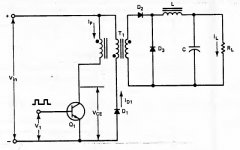rikkitikki
New member
Can not unwind, dont want to rewind, but reuse old tranny. The ATX supply was based on a single switch forward converter with a 450W output , and 80+ certificate and 230V 50Hz input.
EE33 core, I think or quite close, original switching frequency about 100 kHz ( I have to check properly but in this range to get enough power out of the tranny)
Primary 60 turns , and then the reset winding 60 turns, much thinner of course. They are separated, coupled at PCB by capacitor.
Secondary is 4+4+3+3 turns, separable but connected by PCB.
Winding is outer => inner
Primary (1/2) - secondary-secondary-secondary (1/2) -secondary-secondary-reset and throw in two capacitive screen between the windings
Big Question- in a half bridge what to do with the reset winding?
Halfbridge drive with SG3525 and IR XXXX half bridge driver, no feedbuck but a current protection and soft start.
Going half bridge would increase possible power output as the flux losses goes down, and increasing the frequency gives the same V*T as the forward converter but without the reset and better output capacity.
Really, really hardcore would of course be to volt double 230V input and drive the primary in halfbridge at 230V , reusing the old mosfets, but this neccessates using 1200V gate driver IC I think... not quite there yet... I got plenty of 400V caps though...
edit: or of course going full-bridge with 230V AC in. Same voltage swing. Doule
EE33 core, I think or quite close, original switching frequency about 100 kHz ( I have to check properly but in this range to get enough power out of the tranny)
Primary 60 turns , and then the reset winding 60 turns, much thinner of course. They are separated, coupled at PCB by capacitor.
Secondary is 4+4+3+3 turns, separable but connected by PCB.
Winding is outer => inner
Primary (1/2) - secondary-secondary-secondary (1/2) -secondary-secondary-reset and throw in two capacitive screen between the windings
Big Question- in a half bridge what to do with the reset winding?
Halfbridge drive with SG3525 and IR XXXX half bridge driver, no feedbuck but a current protection and soft start.
Going half bridge would increase possible power output as the flux losses goes down, and increasing the frequency gives the same V*T as the forward converter but without the reset and better output capacity.
Really, really hardcore would of course be to volt double 230V input and drive the primary in halfbridge at 230V , reusing the old mosfets, but this neccessates using 1200V gate driver IC I think... not quite there yet... I got plenty of 400V caps though...
edit: or of course going full-bridge with 230V AC in. Same voltage swing. Doule
Last edited:

